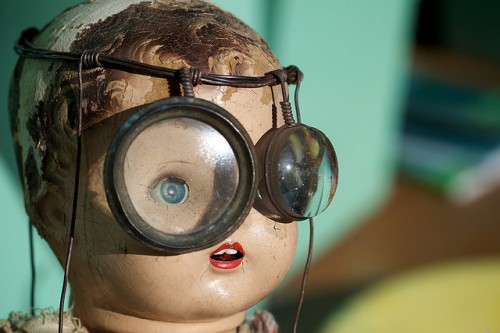
The wearable is going through an adolescence right now. Products like Google Glass, Oculus Rift, or the Pebble smartwatch are a lot like teenagers: They’ve come into their own, but still aren’t sure about the place in society. They are a little awkward, have problems staying awake when they need to be, and they attract derision by the New York Times. And just like human adolescence, this phase probably has a horizon. People could warm up to the idea of face computers, battery life will get better, and (eventually, hopefully) the public will learn to ignore Ross Douthat. But for right now, the wearable is in a precarious situtation. Are wearables like Glass relegated to the same fate as Bluetooth earpieces and the Discman, or can they be saved? Is the entire category irredeemable or have we yet to see the winning execution?
Let’s begin by listing some of the stated problems with wearables. The first and probably best document is Google’s own “Do’s and Don’t’s” guide for Glass explorers. We can pretty fairly assume that 1) not enough people were doing the “Do’s” 2) too many people were doing the “don’ts” and 3) these issues are generalizable across similar devices.
The Don’t’s aren’t very surprising: ask people before taking photos or videos of them, don’t stand around in public staring up into your Glass, and when people ask you about it or request that you take it off, be an adult and acquiesce to reasonable requests and questions. What’s really interesting are the “Do’s” and the very first “do” in particular:
“Glass puts you more in control of your technology and frees you to look up and engage with the world around you rather than look down and be distracted from it.”
A typical rebuttal to the Digital Dualism critique is that it is inherently and uncritically a “pro-technology” argument. That debate has been hashed out elsewhere and continues to grow and develop but it is worth noting here that this is not just a tech company but one of the biggest tech company on the planet making a digital dualist statement: that smartphones distract you from “engaging with the world.” It assumes that there is a “virtual” and a “real” world and that Glass is the perfect solution to the dualism: you can dip into and benefit from the latter without losing track of the former. Its an insidious idea that will make even the biggest and most successful organizations solve problems that don’t exist. Or, perhaps worse, create new problems that could be avoided with relatively simple social theory.
Consider for example, the fairly mundane act of taking a photo. With a phone your body posture makes it fairly obvious that you’re taking a picture: Glass isn’t as obvious. Glass’s prism lights up when its recording a video but this doesn’t mean a whole lot if those around you don’t know what it means when the prism on your face begins to glow. Short of projecting [REC.] on the user’s forehead, body posture might be the best indicator of the device’s state. If Glass required the user to continue touching the side of the device during recording it would not only present a much more obvious indication that the user was interacting with the device, it would also make it physically uncomfortable to record for long stretches of time.

What I just described is a problem with a designed solution but it is informed by several sociological observations. The biggest of which is that all knowledge and practice is situated within a culture. Really big changes to cultures –like the kind Glass and other wearables promise for the tech industry– don’t just adhere soundly to existing orthodoxy, they make new logics and reinterpret existing narratives. Making recording video slightly more difficult is counter-intuitive to what we commonly consider good design and the underlying logic of Google Glass in particular. In fact, if there is a single unifying narrative that connects all consumer devices, it is the idea that technology is best when it is invisible. Devices are meant to be desired (albeit guiltily) but ultimately looked past. Or, as Google Developer Advocate Timothy Jordan said at SXSW 2013 while wearing Google Glass and a fedora: “By bringing technology closer, we can get it more out of the way.”
The idea that the most pleasurable experience with technology is the one you barely notice goes back several decades. Legendary designer and living avatar of German minimalism Dieter Rams, for example, has been prescribing “Good design is unobtrusive” for over 30 years. Echos of Rams’ “Ten Principles of Good Design” (unobtrusiveness is number 5) can be heard in every product announcement and commercial going back for decades. When Steve Jobs introduced the iPod in 2001 it wasn’t pitched as a “hard drive in your pocket” but as “1000 songs in your pocket.” Our devices are supposed to “get out of the way” and let us experience something pure and even visceral. The ideal device would be completely invisible.
This “invisibile device” approach to product design has produced immensely useful and entertaining devices but is, ultimately, a beautiful lie. Technology is always framing scenarios, affording certain social actions at the expense of others, and encouraging (and at times forcing) us to think in terms of likes, tweets, and photos. Designers want their devices to look beautiful but are also taught that the virtual is obtrusive. It is no wonder then, that Glass Explorers are having such a hard time: they’re sold a device that you’re meant to forget because technology is obtrusive, but that obtrusiveness manifests itself every time someone looks at you because you have this device hanging from your face. The sales pitch is that Wearables will make tech fade into the background but maybe that isn’t what the best tech looks like. Maybe the orthodoxy is wrong. After all, interaction with your data may appear unfacilitated and that might feel good, but I suspect that the pursuit of invisible devices breeds Glassholes.
It’s hard (at least for me) to look at Ram’s Ten Principles of Good Design and not think about what Donna Haraway called the “immodest witness.” Scientists and engineers are prone to thinking that their observations and conclusions are self-evident and that their gaze comes from nowhere; that they are not interpreting or translating the natural world through their own standpoint, but merely describing it in an impartial way. This means that undesirable social phenomena like racism or sexism can masquerade as natural phenomena. If you believe without question (as many scientists did and unfortunately still do) that women are naturally subservient to men or that there are clear, separate, and distinct human races, then you’ll go out and find justification for that kind of thinking in your data.
A similar kind of structural bias can be found in Silicon Valley. Back in January I wrote about this phenomena and observed that,
When something isn’t quite designed to your lifestyle you experience it as “I love this thing but I don’t understand why it does X, Y, and Z.” It would seem to follow then, that design incompatibilities between designed object and user would become increasingly obvious as any given user drifts further away from the intended user of the designed object. But that is, generally, not the case. Design something that’s just a little off, and it’s an itch you can’t scratch. Design entire product categories with only specific people in mind and its difficult to imagine the material world any other way.
This issue is blaringly obvious in the demo videos for Glass. A white man (invariably) does a bunch of upper middle class things to impresses a woman. We see, quite literally, the perspective of heteronormative white men and all the things they need to live a better life. It also shows the self-centered behavior that comes with extreme privilege: information is for your eyes only and the world stands ready for your gaze and enjoyment. A small design intervention like the one I described above for image capture asks that the user acknowledge that they are not passive or modest; that the user at least continue to exert some kind of energy in order to take or do what they want.
Can the wearable be saved? Its a difficult question to answer because it is unclear whether the motivating factors for creating the wearable –digital dualism, invisible devices– are the only thing making them desirable. To save the wearable as a device category is to confront and overcome the long-standing, intersecting oversights in the tech industry: assumed body norms, patriarchy, and the clunky way engineers and businessmen talk about “the social.” This isn’t a pedantic problem relevant only to Silicon Valley elites. Solving (or at least coming to a better understanding of) what is wrong with wearables could make for a more inclusive and thoughtful culture of technological development.
David is on Twitter and Tumblr. Also at davidabanks.org

Comments 3
SAA — June 16, 2014
Great piece, David. I particularly like your observation of a great Marking Theory example that what is 'transparent' for one is 'glaringly obvious' for another.
There are other issues that make the wearable, unwearable. Mostly the outcomes from PolySocial Reality (PoSR) -- having an overwhelming volume of multiple multiplexed messages in a constant stream while interacting in the world with others in the same predicament. This invokes Divided Attention of a high order. People can't pay attention to sorting through (what I've often called the 'hundred things problem,' which is now the more than hundred things problem) that data and successfully move around in the world.
In Applin (2012), "Google Glasses? Heads Up!" on this blog, I wrote about the issues with Divided Attention and PoSR for wearables, but also, and this was not picked up on at the time, as a 'human training the machine' mechanism to Improve Google's AI. This is the most critical of the things that wearables will do, feed the AI beast for learning about our behaviors. This can have a good, neutral, or way bad (building cybermen bad) outcome. It remains unknown.
http://thesocietypages.org/cyborgology/2012/04/10/google-glasses-heads-up/
Improving the Wearable » Cyborgology — June 22, 2014
[…] Monday I posed two related questions: “Are wearables like Glass relegated to the same fate as Bluetooth earpieces and the Discman, […]
Sauvons les wearables | Graphisme & Design ... — June 30, 2014
[…] David Banks pour Cyborgology se demande si les wearables, ces ordinateurs qui se portent ont encore un avenir. Pour lui, rendre les dispositifs invisibles est peut-être le principal problème que les Google Glass rencontrent. Ainsi le fait que prendre une photo ou une vidéo soit invisible depuis des Google Glass soit invisible aux autres se révèle plus être un problème qu’autre chose. L’invitation du design à être “discret”, de dire qu’un dispositif idéal serait un dispositif complètement invisible est une erreur. Si nous devions mettre le doigt sur la branche des lunettes par exemple pour enregistrer quelque chose, peut-être que cela changerait l’appréhension que les lunettes de Google cristallisent. “Les lunettes de Google sont vendues comme un dispositif qui est censé vous faire oublier que la technologie est envahissante, mais cet envahissement se manifeste à chaque fois que quelqu’un vous regarde puisque le dispositif est accroché à votre visage”. Et David Banks de mettre en parallèle les 10 principes d’une bonne conception du designer minimaliste allemand Dieter Rams, avec le “témoin impudique” qu’évoquait Donna Haraway, qui évoquait les biais des observateurs dans leur observation… Pour lui, c’est la même chose quand les ingénieurs et designers imaginent des produits avec un seul type d’utilisateur à l’esprit. Les Google Glass favorisent un comportement égocentrique qui met l’information uniquement sous le regard de celui qui les porte et qui prépare le monde à son seul regard et pour son seul plaisir. […]